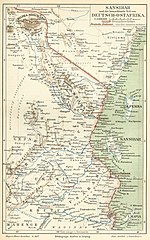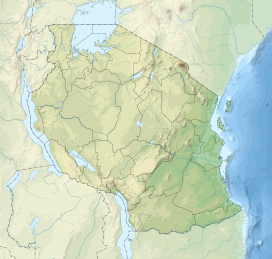| Kilimanjaro | |
|---|---|
 Kibo Summit of Kilimanjaro | |
| Elevation | 5,895 m (19,341 ft) |
| Location | |
| Coordinates | 3°4′33″S 37°21′12″E / 3.07583°S 37.35333°ECoordinates: 3°4′33″S 37°21′12″E / 3.07583°S 37.35333°Ewikipedia.org |
| Topo map | Kilimanjaro map and guide by Wielochowski [2] |
| Geology | |
| Type | Stratovolcano |
| Last eruption | None in recorded history |
| Climbing | |
| Easiest route | Hike |
Contents[hide] |
Name
The exact meaning and origin of the name Kilimanjaro is unknown. It is thought to be a combination of the Swahili word Kilima (meaning "mountain") and the Kichagga word Njaro, loosely translated as "whiteness", giving the name White Mountain. Another variation is "Njaro" in Chagga/Kichagga means "our" and hence Kilimanjaro means our mountain. This is from the Chagga people who live at the base of the mountain.It is unknown where the name Kilimanjaro originates, but a number of theories exist. European explorers had adopted the name by 1860 and reported that it was its Swahili name,[4] with Kilimanjaro breaking into Kilima (Swahili for "hill, little mountain") and Njaro,[5] whose supposed origin varies according to the theories—according to some it's an ancient Swahili word for white or for shining,[6] or for the non-Swahili origin, a word from the Kichagga language, the word jaro meaning "caravan". The problem with all these is that they can't explain why the diminutive kilima is used instead of the proper word for mountain, mlima. The name might be a local joke, referring to the "little hill of the Njaro" being the biggest mountain on the African continent, since this is a nearby town, and guides recount that it is the Hill of the Njaro people. A different approach is to assume that it comes from the Kichagga kilmanare or kileajao meaning "which defeats the bird/leopard/caravan". However this theory cannot explain the fact that Kilimanjaro was never used in Kichagga before in Europe in the mid-19th century.[4]
In the 1880s, the mountain, at that time spelled Kilima-Ndscharo in German following the Swahili name components, became a part of German East Africa after Karl Peters had persuaded local chiefs to sign treaties (a common story that Queen Victoria gave the mountain to her grandson Kaiser Wilhelm II is not true).[7] In 1889 the peak of Kibo was named "Kaiser-Wilhelm-Spitze" ("Kaiser Wilhelm peak") by Hans Meyer, on the first ascent to the summit on 5 October 1889.[4] That name was used until 1918, when after World War I the German colonies were handed over to the British empire. When British-administered Tanganyika gained its independence in 1961, the peak was named "Uhuru peak", meaning "Freedom peak" in Swahili.

Historical map with "Kilima-Ndscharo" in German East Africa, 1888
Geology
Mt. Kilimanjaro is the highest mountain in Africa and fourth highest of the Seven Summits. It is the tallest freestanding mountain in the world, with Uhuru Peak rising to an altitude of 5,895 m (19,341 ft) AMSL (Above Mean Sea Level).Kilimanjaro is composed of three distinct volcanic cones: Kibo 5,895 m (19,341 ft); Mawenzi 5,149 m (16,893 ft); and Shira 3,962 m (13,000 ft). Uhuru Peak is the highest summit on Kibo's crater rim.
Kilimanjaro is a giant stratovolcano that began forming a million years ago, when lava spilled from the Rift Valley zone. Two of its three peaks, Mawenzi and Shira, are extinct while Kibo (the highest peak) is dormant and could erupt again. The last major eruption has been dated to 360,000 years ago, while the most recent activity was recorded just 200 years ago.
Although it is dormant, Kilimanjaro has fumaroles that emit gas in the crater on the main summit of Kibo. Scientists concluded in 2003 that molten magma is just 400 m (1,310 ft) below the summit crater.[citation needed] Several collapses and landslides have occurred on Kibo in the past, one creating the area known as the Western Breach.
Mapping
Early maps of Kilimanjaro were published by the British Government's Directorate of Overseas Surveys (DOS 422 Y742) in 1963. These were based on air photography carried out as early as 1959 by the RAF. These were on a scale of 1:50,000 with contours at 100 ft intervals. These are now unavailable. Tourist mapping was first published by the Ordnance Survey in England in 1989 based on the original DOS mapping (1:100,000, 100 ft intervals, DOS 522). This is now no longer available. EWP produced a map with tourist information in 1990 (1:75,000, 100 m contour intervals, inset maps of Kibo and Mawenzi on 1:20,000 and 1:30,000 scales respectively and 50 m contour interval). In the last few years, numerous other maps have become available of various qualities.[2]3D Route Maps.[8]
Trekking routes up Kilimanjaro
Main article: Mount Kilimanjaro climbing routes
There are six[9] official climbing routes [10] by which to climb Mt Kilimanjaro, namely: Marangu, Rongai, Lemosho,[11] Shira, Umbwe and Machame. Of all the routes, Machame[12] is by far the most scenic albeit steeper route up the mountain, which can be done in six or seven days.[13] The Rongai is the easiest camping route and the Marangu is also relatively easy, but accommodation is in huts. As a result, this route tends to be very busy, and ascent and descent routes are the same.People who wish to climb Mt Kilimanjaro are advised to undertake appropriate research[14] and ensure that they are both properly equipped and physically capable. Though the climb is technically not as challenging as when climbing the peaks of the Himalayas, the altitude, low temperature, and occasional high winds make this a difficult and dangerous trek. Acclimatisation is essential, and even then most experienced climbers suffer some degree of altitude sickness.[15] Kilimanjaro summit is well above the altitude at which high altitude pulmonary edema (HAPE), or high altitude cerebral edema (HACE) can occur.[16] All climbers will suffer considerable discomfort, typically shortage of breath, hypothermia and headaches, and though most young, fit people can make the Uhuru summit, a substantial number of trekkers will abandon the attempt at a lower altitude.

Memorial recognizing Hans Meyer as the first European to "conquer" Kilimanjaro
Tanzanian Medical Services around the mountain have expressed concern recently[when?] over the current influx of tourists that apparently perceive Kilimanjaro as an easy climb. However this is not the case. Many individuals require significant attention during their attempts, and many are forced to abandon the climb. An investigation into the matter concluded that tourists visiting Tanzania were often encouraged to join groups heading up the mountain without being made aware of the significant physical demands the climb makes, although many outfitters and tour operators flaunt high success rates for reaching the summit. The Kilimanjaro national park shows that only 30% of climbers actually reach the Uhuru summit with the majority of climbers turning around at Gilman’s Point, 300 metres short of Uhuru, or Stella Point, 200 meters short of Uhuru. Kilimanjaro is often underestimated because it is not a technical climb. However, many mountaineers consider Kilimanjaro a very physically demanding climb.
Some estimate that more people have died to date climbing Kilimanjaro than Mount Everest but Everest is attempted by much fewer climbers.[citation needed] In August 2007 four climbers died within a week underscoring the point that climbing it should not be taken casually. Multiple people (climbers, porters, and guides) die on the mountain each year. Majority of these deaths are porters, from hypothermia. Climbers fall on steep portions of the mountain and rock slides have killed climbers. For this reason, the route via the Arrow Glacier was closed for several years. It has recently[when?] been opened again, but the park officials advise against taking that route and tell climbers that they can climb at their own risk. When attempting the Arrow Glacier route, climbers must leave early in the morning and make it past the rock face before mid-afternoon as when the sun comes out, unfrozen rock slides become quite common.
Unique vegetation
Being a sky island, Kilimanjaro has many endemic species, including the giant groundsels in the tussock grassland and other plants adapted to living in alpine conditions.Kilimanjaro has a large variety of forest types over an altitudinal range of 3,000 m (9,843 ft) containing over 1,200 vascular plant species. Montane Ocotea forests occur on the wet southern slope. Cassipourea and Juniperus forests grow on the dry northern slope. Subalpine Erica forests at 4,100 m (13,451 ft) represent the highest elevation cloud forests in Africa. In contrast to this enormous biodiversity, the degree of endemism is low. However, forest relicts in the deepest valleys of the cultivated lower areas suggest that a rich forest flora inhabited Mt Kilimanjaro in the past, with restricted-range species otherwise only known from the Eastern Arc mountains. The low degree of endemism on Kilimanjaro may result from destruction of lower altitude forest rather than the relatively young age of the mountain. Another feature of the forests of Kilimanjaro is the absence of a bamboo zone, which occurs on all other tall mountains in East Africa with a similarly high rainfall. Sinarundinaria alpina stands are favoured by elephants and buffaloes. On Kilimanjaro these megaherbivores occur on the northern slopes, where it is too dry for a large bamboo zone to develop. They are excluded from the wet southern slope forests by topography and humans, who have cultivated the foothills for at least 2000 years. This interplay of biotic and abiotic factors could explain not only the lack of a bamboo zone on Kilimanjaro but also offers possible explanations for the patterns of diversity and endemism. If true, Kilimanjaro's forests would serve as a striking example of the large and long-lasting influence of both animals and humans on the African landscape.





Tidak ada komentar:
Posting Komentar